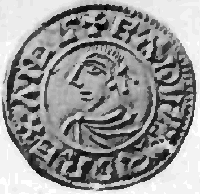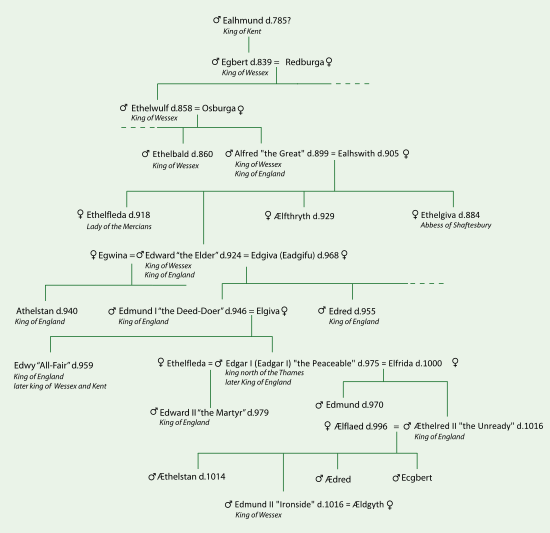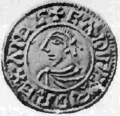Edward the Martyr facts for kids
Quick facts for kids Edward the Martyr |
|||||
|---|---|---|---|---|---|
| King of England | |||||

Coin of Edward the Martyr
|
|||||
| Reign | July 8, 975 - March 18, 978 | ||||
| Predecessor | Edgar “The Peaceful” | ||||
| Successor | Ethelred the Unready | ||||
| Born | 962 Wessex, England |
||||
| Died | March 18, 978 Corfe Castle, Dorset |
||||
| Burial | Brookwood Cemetery Wareham, Dorset | ||||
|
|||||
| Father | Edgar | ||||
| Mother | Ethelfleda | ||||
| Religion | Christian | ||||
King Edward the Martyr (born around 962 – died March 18, 978) was a young king of England. He became king in 975 after his father, King Edgar, passed away. Sadly, Edward was killed after ruling for only three years.
He was later declared a martyr, which means someone who dies for their beliefs. In 1001, he was officially recognized as Saint Edward the Martyr. People believed Edward was a very good Christian who died because of his strong faith. They thought his killers were not religious.
Contents
Why King Edward Was Killed
Edward's stepmother, Queen Elfrida, did not want him to be king. She wanted her own son, Ethelred, to take the throne instead. However, many important people, including Saint Dunstan, supported Edward. A council of wise leaders, called the Witan, also agreed he should be king.
People described King Edward as a kind and religious young man. They said he loved God and the Church very much. He was generous to poor people and always stood up for his Christian faith.
When Edward became king, there was a big problem with food shortages across the land. Also, some powerful noblemen attacked monasteries. They wanted the lands that King Edgar had given to these religious places. Many monasteries were destroyed, and the monks had to run away. But King Edward, along with Archbishop Dunstan, bravely defended the Church and the monasteries. Because of this, some nobles decided to get rid of him and put his younger brother Ethelred on the throne.
On March 18, 978, King Edward was hunting near Wareham in Dorset. He decided to visit his young brother Ethelred, who was living with their mother Elfrida at Corfe Castle. Edward arrived at the castle alone. While he was still on his horse, Elfrida offered him a drink of mead. As he was drinking, someone from the queen's group stabbed him in the back. Ethelred was only ten years old at the time, so he was not responsible for the killing. Another story, from Henry of Huntingdon, says that Elfrida herself did the deed. He wrote that she "stabbed him with a dagger while she was in the act of offering him a cup to drink."
Edward's Family Tree
The Story of His Holy Remains
The story of St. Edward's relics (his remains) began right after he was killed. After being stabbed, the king's body fell from his horse. It was dragged with one foot still in the stirrup until it dropped into a stream near Corfe Castle. People later believed this stream gained special healing powers, especially for those who couldn't see.
The queen ordered Edward's body to be hidden quickly in a nearby hut. Inside the hut lived a woman who had been blind since birth. During the night, a bright light filled the hut. The woman cried out and suddenly could see! She then found the king's dead body. Today, the church of St. Edward at Corfe Castle stands where this miracle happened.
At dawn, the queen heard about the miracle. She was worried and ordered the body to be buried again, this time in a marshy area near Wareham. But a year later, a bright column of fire appeared over the burial spot, lighting up the whole area. Some people from Wareham saw this and dug up the body. Right away, a clear spring of healing water appeared there. A large crowd of mourners then took the body to the church of the Most Holy Mother of God in Wareham. It was buried there on February 13, 980.
Because many miracles kept happening, St. Edward's relics were moved to Shaftesbury Abbey. When his body was taken from the grave, it was found to be whole and not decayed. The transport of the relics was a huge procession on February 13, 981. They arrived at Shaftesbury seven days later. The nuns of Shaftesbury Abbey welcomed the relics and buried them with royal honors. On the way to Shaftesbury, another miracle happened: two men who couldn't walk were brought near the king's body. When the body was lowered to them, they were instantly healed. This journey was even re-enacted 1000 years later in 1981!
In 1001, people noticed that the tomb where the saint lay seemed to rise from the ground regularly. King Ethelred was happy about this. He told the bishops to move his brother's tomb to a more special place. When the tomb was opened, a wonderful smell filled the air, making everyone feel like they were "standing in Paradise." The bishops then took the holy relics and placed them in a special casket with other holy items. This happened on June 20, 1001.
St. Edward was officially recognized as a saint by a big council in England in 1008. King Ethelred ordered that three special days (March 18, February 13, and June 20) should be celebrated across England in honor of his brother. Shaftesbury Abbey was even renamed "Edwardstowe" for a time. Many miracles were recorded at St. Edward's tomb, including the healing of people with leprosy and those who were blind.
During the 1500s, under King Henry VIII, many religious places were closed down. But St. Edward's remains were hidden to keep them safe. In 1931, a man named Mr. Wilson-Claridge found the relics during an archaeological dig. Tests in 1970 showed that the young man had been stabbed in the back while riding a horse and then dragged along the ground. Around 1982, Mr. Wilson-Claridge gave the relics to the Russian Orthodox Church Outside Russia. They are now kept in a church at Brookwood Cemetery in Woking, Surrey. This church is called St Edward the Martyr Orthodox Church.
Images for kids
-
A penny minted during Edward's reign at Stamford, Lincolnshire
-
Corfe Castle from below
-
The Great Seal of Shaftesbury Abbey, where Edward's relics lay until the English Reformation
-
The Shrine of St Edward in the Church of St. Edward the Martyr, Brookwood (2018)
-
Plaque to John Edward Wilson-Claridge at the Church of St. Edward the Martyr, Brookwood; he found and gave the supposed remains of Edward the Martyr
See also
 In Spanish: Eduardo el Mártir para niños
In Spanish: Eduardo el Mártir para niños







